
A mango is an edible stone fruit produced by the tropical tree Mangifera indica. It is believed to have originated in southern Asia, particularly in eastern India, Bangladesh, and the Andaman Islands. M. indica has been cultivated in South and Southeast Asia since ancient times resulting in two types of modern mango cultivars: the "Indian type" and the "Southeast Asian type". Other species in the genus Mangifera also produce edible fruits that are also called "mangoes", the majority of which are found in the Malesian ecoregion.

A plum is a fruit of some species in Prunus subg. Prunus. Dried plums are most often called prunes, though in the United States they may be just labeled as 'dried plums', especially during the 21st century.

Guava is a common tropical fruit cultivated in many tropical and subtropical regions. The common guava Psidium guajava is a small tree in the myrtle family (Myrtaceae), native to Mexico, Central America, the Caribbean and northern South America. The name guava is also given to some other species in the genus Psidium such as strawberry guava and to the pineapple guava, Feijoa sellowiana. In 2019, 55 million tonnes of guavas were produced worldwide, led by India with 45% of the total. Botanically, guavas are berries.

Costa Rican cuisine is known for being mostly mild, with high reliance on fruits and vegetables. Rice and black beans are a staple of most traditional Costa Rican meals, often served three times a day. Costa Rican fare is nutritionally well rounded, and nearly always cooked from scratch from fresh ingredients. Owing to the location of the country, tropical fruits and vegetables are readily available and included in the local cuisine.
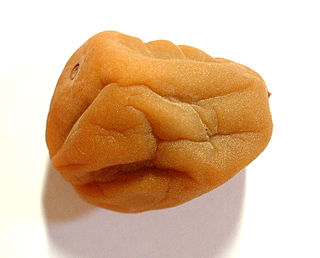
Umeboshi are pickled (brined) ume fruits common in Japan. The word umeboshi is often translated into English as 'salted Japanese plums', 'Japanese plums' or 'preserved plums'. Ume is a species of fruit-bearing tree in the genus Prunus, which is often called a "plum", but is actually more closely related to the apricot. Pickled ume which are not dried are called umezuke (梅漬け).

Filipino cuisine is composed of the cuisines of more than a hundred distinct ethnolinguistic groups found throughout the Philippine archipelago. A majority of mainstream Filipino dishes that compose Filipino cuisine are from the food traditions of various ethnolinguistic groups and tribes of the archipelago, including the Ilocano, Pangasinan, Kapampangan, Tagalog, Bicolano, Visayan, Chavacano and Maranao ethnolinguistic groups. The dishes associated with these groups evolved over the centuries from a largely indigenous base shared with maritime Southeast Asia with varied influences from Chinese, Spanish and American cuisines, in line with the major waves of influence that had enriched the cultures of the archipelago and adapted using indigenous ingredients to meet local preferences.

Spondias purpura is a species of flowering plant in the cashew family, Anacardiaceae, that is native to tropical regions of the Americas, from Mexico to northern Colombia and the southwest Caribbean Islands. It has also been introduced to and naturalized to other parts of the American tropics, Southeast Asia, and West Africa. It is commonly known as jocote, which derives from the Nahuatl word xocotl, meaning any kind of sour or acidic fruit. Other common names include red mombin, Spanish plum, purple mombin, Jamaica plum, and hog plum.

Indigenous cuisine of the Americas includes all cuisines and food practices of the Indigenous peoples of the Americas. Contemporary Native peoples retain a varied culture of traditional foods, along with the addition of some post-contact foods that have become customary and even iconic of present-day Indigenous American social gatherings. Foods like cornbread, turkey, cranberry, blueberry, hominy and mush have been adopted into the cuisine of the broader United States population from Native American cultures.
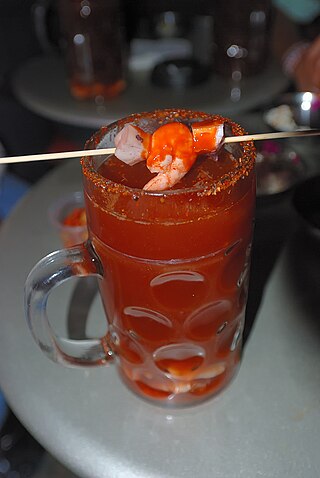
A michelada is a Mexican drink made with beer, lime juice, assorted sauces, spices, and chili peppers. It is served in a chilled, salt-rimmed glass. There are numerous variations of this beverage throughout Mexico.

Crack seed is a category of snacks that originated in China. It is highly popular in many regions, such as Hawaii. Crack seed are preserved fruits that have been cracked or split with the seed or kernel partially exposed as a flavor enhancement. This type of snack is commonly referred to in the Cantonese language as see mui ; it arrived in Hawaii during the 19th century, when Cantonese immigrants were brought to work on the plantations. The larger numbers of Japanese who later came to work on the plantations adopted the snack, being similar to the Japanese umeboshi.
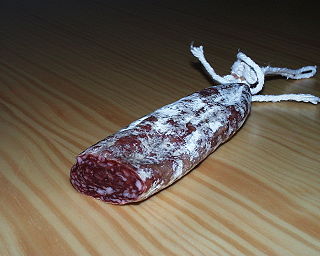
Longaniza is a Spanish sausage (embutido) similar to a chorizo and also closely associated with the Portuguese linguiça. Its defining characteristics are interpreted differently from region to region. It is popular in the cuisines of several regions of Spain, Argentina, Uruguay, Puerto Rico, Dominican Republic, El Salvador, Guatemala, Mexico and Chile. In the Philippines, it is called longganisa and has hundreds of variants with different vernacular tastes and forms due to the 144 ethno-linguistic groups of the archipelago.

Shaved ice is a large family of ice-based desserts made of fine shavings of ice and sweet condiments or syrups. Usually, the syrup is added after the ice has been frozen and shaved—typically at the point of sale; however, flavoring can also be added before freezing. The dessert is consumed worldwide in various forms and ways. Shaved ice can also be mixed with large quantities of liquid to produce shaved ice drinks.

Spondias dulcis, known commonly as June plum, is a tropical tree, with edible fruit containing a fibrous pit. In the English-speaking Caribbean it is typically known as golden apple and elsewhere in the Caribbean as pommecythere or cythere. In Polynesia it is known as vī.
An acquired taste is an appreciation for something unlikely to be enjoyed by a person who has not had substantial exposure to it. It is the opposite of innate taste, which is the appreciation for things that are enjoyable by most persons without prior exposure to them.
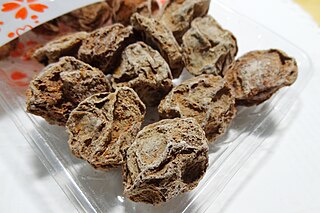
Li hing mui, known as huamei in Mainland China, is salty dried Chinese plum. It has a strong, distinctive flavor and is often said to be an acquired taste, as it has a combination of sweet, sour, and salty taste. Originally from Guangdong Province, the name "li hing mui" means "traveling plum". "Li hing" is "traveling" and "mui" is "plum" in Cantonese. Li hung mui is called hoshiume in Japan, where the salty and sour umeboshi is also popular. Li hing mui, along with li hing powder, is extremely popular as a snack in Hawaii.

ChamoySpanish pronunciation:[t͡ʃaˈmoi̯] is a variety of savory sauces and condiments in Mexican cuisine made from pickled fruit. Chamoy may range from a liquid to a paste consistency, and typically its flavor is salty, sweet, sour, and spiced with chilies.
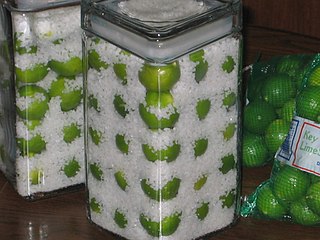
Pickled fruit refers to fruit that has been pickled. Pickling is the process of food preservation by either anaerobic fermentation in brine or immersion in vinegar. Many types of fruit are pickled. Some examples include peaches, apples, crabapples, pears, plums, grapes, currants, tomatoes and olives. Vinegar may also be prepared from fruit, such as apple cider vinegar.

Kamayan, also known as kinamot or kinamut in Visayan languages, is the traditional Filipino method of eating with the bare hands. It is also used to describe the Filipino communal feast where food is served on banana leaves and eaten without utensils.
Kiamoy, is a class of Filipino treats made with dried sour plums, prunes, or apricots preserved in brine and vinegar. They are sold covered in a powdery coating of an anise, li hing, salt, and sugar mixture called "kiamoy powder" or kiam-muy-hoon. They are characteristically bright red, orange, or light brown in color. They originate from Chinese Filipino immigrants and are derived from the li hing mui (旅行梅) treats of Chinese cuisine. The name is derived from Philippine Hokkien Chinese: 鹹梅; Pe̍h-ōe-jī: kiâm-muî; lit. 'salted plum'.
















